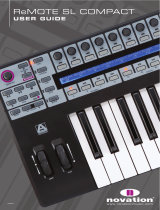
2
TABLE OF CONTENTS
Introduction to Automap 4 ..........................3
Registration ............................................................................... 3
Automap 4 minimum system requirements ........................... 3
Apple Mac ......................................................................... 3
Windows ........................................................................... 3
Installing Automap 4 software and drivers ........................... 3
List of DAWs ofcially supported ............................................ 5
Conguring Automap 4 for your DAW and hardware ............4-6
Managing your Plug-ins ..............................6
Adding VST Folders (Windows only) ..................................... 7
Automap 4 File Handling (Advanced Users Only) ................. 7
Automap Terminology ..................................8
DAW .................................................................................... 8
Device ................................................................................ 8
Mappings ........................................................................... 8
The Edit Mapping Window ............................................... 8
Plug-in ................................................................................ 8
Mixer ................................................................................... 8
Thing .................................................................................. 8
Automap HUI ..................................................................... 8
Automap MIDI .................................................................... 8
Control ............................................................................... 8
Using Automap 4 ..........................................9
Edit Mapping window – general ............................................... 9
Using the Edit Mapping window with Impulse ..................... 11
Using the Edit Mapping window with other ......................... 12
Novation Automap-compatible hardware
Automap Browser View .......................................................... 13
Thing Order ............................................................................. 14
Re-ordering Things ................................................................. 14
Recording Parameter Automation When Using Automap 4 .. 14
Creating your own Mappings .................... 14
Manual Parameter Assignments ........................................... 14
Parameter Assignment using Learn ..................................... 14
Learn latch mode with other Novation Automap
compatible hardware .............................................................. 15
Quick Re-ordering of Parameters ......................................... 15
Renaming Parameters ............................................................ 15
Mixer Mode .................................................. 16
Mixer Automap ......................................................................... 17
Saving Mixer Mappings........................................................... 17
Automap HUI – Controlling HUI supported Mixers ........ 17-18
Automap Virtual MIDI
(applicable only to certain Novation Automap -
compatible products)
Setting up MIDI Channels and Ports ..................................... 18
Other Virtual Automap MIDI functions.................................. 19
Saving your custom Automap MIDI Maps ............................ 19
Multiple Hardware Devices
Focus Device ............................................................................ 19
Saving Mappings when using multiple controllers ............. 20
Mixer/Plugin Mappings page .................................................. 20
Keystroke Assignments
Appendix
Editing Controls .............................................................. 21
Editing Encoders ........................................................... 21
Hardware Settings: Encoder Acceleration ................. 22
Editing Buttons ..........................................................22-23
Editing Pots and Sliders ................................................ 24
Automap File Handling (Advanced Users Only) .................. 25
Setting Automap 4 Preferences....................................25
General .......................................................................25-26
Notications ....................................................................26
Controls ...........................................................................26
Novation contact details ............................26




















